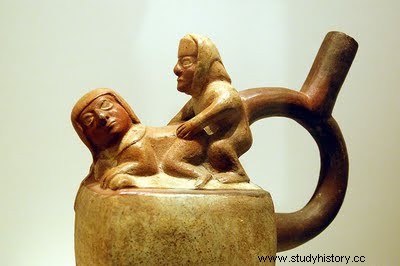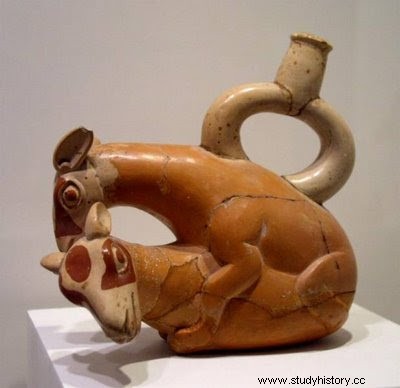
In this way it cannot be applied or prejudiced against the societies that we call primitive or ancient without first analyzing the reason for their actions and asking ourselves, what lessons can be drawn from them? And can this teaching serve the man of today or tomorrow? Based on these questions that open up controversial issues, as is always the case of sexuality (especially taken in ancient societies such as the Peruvian) we seek to find, if not answers, references that help understand this that could, if not should, be considered an art and part of the culture of a people, and not simplepornography.The points to be discussed are the following:
Part I :Sexuality in ancient Peru. Font types: a) Thechronic,
b) Works written by archaeologists, anthropologists and historians based on diverse material and archaeological remains. Part II :Chronology and statistics of erotic-sexual representations in Ancient Peru. Part III: Moche visual culture. ideological context. Part IV :Variants in the Moche sexual act. The five phases of Moche Erotic-sexual art. Homo erotic activities in Moche pottery. V Part :Prostitution among ancient Peruvians and the servinacuy or Trial marriage .
i. sexuality in ancient Peru. The life of the ancient Peruvians was surely inspired and regulated by their observations of nature. Their concrete thought was enriched by trying to explain the facts that they collected with all their senses and that they imitated and surely perfected. Thus, sexual manifestations are present in various periods of pre-Hispanic culture, especially in its ceramics, ranging from the simple anatomical presentation of the external genitalia, of both sexes, to the detailed illustration of sexual relations practiced in various modalities. "The interpretations about sexual manifestations in pre-Hispanic art are very varied. Opinions vary from an outright rejection of what some consider or considered a ''degeneration'', which justified, according to them, the harsh term of "pornography''. ''Manifestations in pre-Hispanic pottery''. Miranda C. Hernan. 1993:141). Dr. Pedro Weiss, an eminent investigator of the diseases of ancient Peruvians, wisely said:''it is not reasonable to explain or interpret ancient facts based on modern criteria'' ( expressed in conferences) . This astute observation invalidates an interpretation of sexual manifestations with ethical and religious criteria that were not valid at the time in which these societies lived. The sound advice of Dr. Weiss frees us from the error of applying modern interpretations and beliefs to practices that occurred two thousand years ago. According to Dr. Cevallos Quiñones (‘’Area and phase of the Moche culture’’ 1985:102) y Taking the case of one of the most representative cultures on this subject, such as the Moche culture, we could affirm that:“the ceramics, including those that represent erotic paintings, were part of the funerary trousseau, since they are found in tombs.

If this type of artistic manifestation had any offensive and immoral meaning It would not be understood for what reason they could have been placed next to the remains of a loved one, in a trance marked by pain and reverence''. As for the character and intention of the ceramics with erotic expressions, the serenity of the judgments is dissipating, as we accept that the symbols and values of the pre-Columbian peoples were different from those of our time, in which some doctrines of very rigorous principles arrived to associate sexual manifestations with sin and condemnation. Another approach by the writer Eugenio Alarco (''The Peruvian man in his history' '. Ch 10) says the following:''We must remember that most cultures, among which are the Hebrew-Christian, have considered and continue to consider sexual relations, not as one of the natural and good things in life. Among us this does not happen, only with the jungle. The current Aymaras of Chucuito, the Quechua shepherds of the Puna of Paratia, in Puno, the indigenous people of Chavin de Huantar and undoubtedly many others think that these relationships are something natural and pleasant and should not be a matter of conflict. Thus we can appreciate that for many writers, historians, archaeologists and even doctors; the sexual act and sexuality in its entirety did not represent (in ancient times) nor do they represent (today) degenerative and pornographic behaviors, but rather a whole act of natural and even artistic manifestations that were part of the social development of communities.
The sources. Types:
bidi-font-weight:normal;">a) The Chronicles. Documents written, collected and left by the Spanish, mestizos and even Indians. The chronicle is by nature a vernacular genre that springs from history. The Castilian chronicle had, above all, as its own characteristic, an ascetic and moralizing tendency. (‘’Loscronistas del Perú’’. Porras B. Raúl. 1962). The chronicles, although they are indicative documents, informers, perhaps heralds, nevertheless they are debatable and, in general, they can and should be questioned in the light of investigations and subsequent discoveries, also current and surely future. As stated by Rafael Larco Hoyle:''the chronicles are pages that transmit superficial and incomplete information about the sexual life of the ancient Peruvians (...) some narrations were written from the year 1557, we cannot take them as a cornerstone to know what happened in days of violence and the subjugation of a people that only knew an ideographic script and that, in oral testimony, would necessarily have to be, if not hermetic, at least not very talkative. They are the chroniclers, sometimes, more given to the bombastic style of the text than to the beauty of reality (...) ’’. (Essay on the erotic representations of pre-Columbian Peru’’. Larco H.Rafael. 1966).
But not everything written in the chronicles can be discarded. They are navigation charts that must be taken as indications from which complementary research must be deepened, even if it were simply by comparison. "Although on the one hand the chronicles are a valuable information document to clarify many aspects of the complicated and varied plot of life in ancient Peru; on the other hand, with regard to religious and sexual aspects in particular, I believe that most of them are "contaminated with prejudices" for reasons of a cultural nature, such as those of an ideological, philosophical, moral, ethical order, etc. From where the chroniclers come, all of them mostly totally alien to understand the nature and essence of this new culture radically different from theirs.'' (Conception of sexuality in Ancient Peru''. Vergara M. Enrique. 1993:149).

The chroniclers of Ancient Peru are numerous and differ among them in various aspects:the time in which they wrote, the place where they did it, the profession they practiced or the ideology they defended. That is why it is not easy to obtain conclusions that can be considered definitive. And if this is so for general aspects, it is even more difficult and complicated for those of sexuality in particular. Let us see in greater detail the opinion of one of the first chroniclers on the sexual life of the pre-Columbian Peruvian settler. Pedro Cieza de León, arrives in Peru in 1548, according to Porras Barrenechea embodies a spirit of peace and civility, he is the first chronicler who undertakes Peruvian, indigenous and Spanish history. (Sexuality in pre-Columbian Peru’’. Cáceres V. Artidoro. P. 25). Don Pedro Cieza de León published his "Chronicle of Peru" from 1553. Let's see some aspects related to the sexuality of the ancient Peruvians, found in his work. In Chapter X of the second part it is described:'' how the lord, after taking the tassel of the kingdom, married his sister the Coya, which is the queen's name; and how it was allowed to have many women, except that among all the Coya was the legitimate and the most important. One of the topics that many chroniclers dwell on is that of incestuous unions between brothers. It is said that Túpac Inca Yupanqui would have been the first monarch to join his sister, arguing that since both spouses should worship the same grandfather, the union was perfect.
b) Works written by archaeologists, anthropologists and historians based on diverse material and archaeological remains. A very valuable source for learning about the sexuality of pre-Columbian Peruvians is archeology or, better still, archaeological remains. Metallic objects show naked human bodies in which the genitals are prevalently and importantly detailed. ’Statuettes as
Federico Kauffmann Doig (Archaeological Peru -1976) , A great scholar of sexual behavior in ancient Peruvians, he raises the possibility that the tombs or funerary towers "chullpas" have a penile shape and represent a form of phallic worship. But the best, most abundant, clear and unobjectionable archaeological remains of a sexual nature are the ceramic pieces or ''Huacos''. There are hundreds of ceramics of an erotic or sexual nature, distributed in museums or private collections. In all these places are the huacos that show the theme of sexuality and a clear, evident and pedagogical teaching of the sexual customs of the ancient Peruvians. The erotic manifestations in pre-Inca ceramics seem to have flourished in the so-called Auge or Classic period. It is interesting to note that the refinement in sexual ceramics reaches its maximum expression or apogee at the end of that boom period. (‘’Sexuality in pre-Columbian Peru’’. Cáceres V. Artidoro. P. 88).

Now you can read or iconize or interpret the symbolic or representative content of these archaeological objects:caresses , kisses, representation of genitals, genital manipulation, masturbation, various coital positions, homosexuality and even attempted penile amputation that could indicate a gesture of transsexualism, urogenital sexual practices, scenes of childbirth, group coitus and animals, among other representations, they point to the knowledge and rich sexual practice of the ancient Peruvians. Some specimens present diseases and others in which one or more subjects have cadaverous faces, perhaps pointing to a moralizing or educational attempt. There is also evidence of a mystical-religious nature and others that represent isolated sexual organs such as pitchers or vessels and some true genital substitutes and perhaps female and/or male “dildos”.

II. Chronology and Statistics of erotic-sexual representations in Ancient Peru. Within a chronological framework of the Ancient Peruvian, Pre-Inca and Inca Cultures, valuable artistic representations have been manifested in relation to themes with sexual motives. ’For example, the stylistic patterns of the great Chavín era (
The author only refers to the percentageization in the Moche culture and only refers to vaginal or anal intercourse. (Sexuality in pre-Columbian Peru’’. Cáceres V. Artidoro. P. 89-90).
CONTINUED ON NEXT PAGE..
